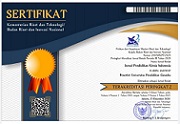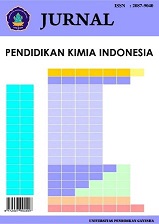The Development of Interactive Multimedia on The High School’s Nanotechnology
DOI:
https://doi.org/10.23887/jpki.v8i1.73130Keywords:
Interactive multimedia, nanotechnology, merdeka curriculumAbstract
The lack of learning resources and media on nanotechnology, a new topic in the High School Merdeka curriculum, is challenging for teachers. Therefore, high school students in Indonesia still need to use interactive multimedia in learning activities to help them understand the learning material. This research aims to (1) create products in the form of interactive multimedia that meet the eligibility criteria and (2) know students' responses to interactive multimedia. ADDIE development mode was used in this research. A total of 10 students in class X SMA Pangudi Luhur Sedayu were sampled in the limited trial. The results showed that: (1) the product has the eligibility criteria with average percentage of 88,7% fulfilled very feasible criteria; fulfilled very valid criteria with an average of 88,7%, fulfilled very effective criteria on an average of 87, fulfilled very practical criteria with an average of 89%; (2) the response of students to the product is very good and gets good comments. The developed interactive multimedia can support the nanotechnology learning process in senior high schools.
References
Ahire, Satish Arvind, Ashwini Ashok Bachhav, Thansing Bhavsing Pawar, Bapu Sonu Jagdale, Arun Vitthal Patil, and Prashant Bhimrao Koli. 2022. “The Augmentation of Nanotechnology Era: A Concise Review on Fundamental Concepts of Nanotechnology and Applications in Material Science and Technology.” Results in Chemistry 4:100633. doi: https://doi.org/10.1016/j.rechem.2022.100633. DOI: https://doi.org/10.1016/j.rechem.2022.100633
Akbar, Sa’dun. 2013. Instrumen Perangkat Pembelajaran. Bandung: PT.Remaja Rosdakarya.
Akbar, Taufik Nuril. 2016. “Pengembangan Multimedia Interaktif IPA Berorientasi Guided Inquiry Pada Materi Siste Pernapasan Manusia Kelas V SDN Kebonsari 3 Malang.” Jurnal Pendidikan:Teori, Penelitian, Dan Pengembangan 1(6):1120–26. doi: http://dx.doi.org/10.17977/jp.v1i6.6456.
Anam, Khoirul, and Tijan. 2022. Media Kuis Interaktif Berbantuan Lectora Inspire. Semarang: Penerbit Cahaya Ghani Recovery.
Ananda, Adeliya Putri, and Hudaidah. 2021. “Perkembangan Kurikulum Pendidikan Indonesia Dari Masa Ke Masa.” Sindang 8(2):102–8. doi: https://doi.org/10.31540/sindang.v3i2. DOI: https://doi.org/10.31540/sindang.v3i2.1192
Anwar, Alfin. 2022. “Media Sosial Sebagai Inovasi Pada Model PjBL Dalam Implementasi Kurikulum Merdeka.” Inovasi Kurikulum 19(2):239–50. doi: https://doi.org/10.17509/jik.v19i2.44230. DOI: https://doi.org/10.17509/jik.v19i2.44230
Arikunto, S. 2013. Prosedur Penelitian: Suatu Pendekatan Praktek. Jakarta: Rineka Cipta.
Ayu Permata Sari, and Suryelita Suryelita. 2023. “Uji Validitas E-Modul Struktur Atom-Keunggulan Nanoteknologi Sesuai Kurikulum Merdeka Untuk Peserta Didik SMA/MA Fase E.” Jurnal Pendidikan Mipa 13(1):235–142. doi: https://doi.org/10.37630/jpm.v13i1.867. DOI: https://doi.org/10.37630/jpm.v13i1.867
Bayda, Samer, Muhammad Adeel, Tiziano Tuccinardi, Marco Cordani, and Flavio Rizzolio. 2019. “The History of Nanoscience and Nanotechnology: From Chemical–Physical Applications to Nanomedicine.” Molecules 25(1):112. doi: https://doi.org/10.3390/molecules25010112. DOI: https://doi.org/10.3390/molecules25010112
F, Rati, Salastri Rohiat, and Elvinawati Elvinawati. 2022. “Pengembangan Multimedia Pembelajaran Interaktif Berbasis Problem Based Learning (PBL) Menggunakan Aplikasi Articulate Storyline Pada Materi Ikatan Kimia.” ALOTROP 6(1):70–79. doi: https://doi.org/10.33369/alo.v6i1.21799. DOI: https://doi.org/10.33369/alo.v6i1.21799
Gregory, Robert J. 2007. Psychological Testing. England: Pearson Education Limited.
Kemendikbudristek. 2022. Keputusan Menteri Pendidikan, Kebudayaan, Riset, Dan Teknologi Republik Indonesia. Jakarta: Kemendikbudristek.
Malik, Shiza, Khalid Muhammad, and Yasir Waheed. 2023. “Nanotechnology: A Revolution in Modern Industry.” Molecules 28(2):661. doi: https://doi.org/10.3390/molecules28020661. DOI: https://doi.org/10.3390/molecules28020661
Manurung, Purbatua. 2021. “Multimedia Interaktif Sebagai Media Pembelajaran Pada Masa Pandemi Covid 19.” Al-Fikru: Jurnal Ilmiah 14(1):1–12. doi: https://doi.org/10.51672/alfikru.v14i1.33. DOI: https://doi.org/10.51672/alfikru.v14i1.33
Putri, Yola Dewi, Rina Elvia, and Hermansyah Amir. 2021. “Pengembangan Media Pembelajaran Kimia Berbasis Android Untuk Meningkatkan Motivasi Belajar Peserta Didik.” ALOTROP, Jurnal Pendidikan Dan Ilmu Kimia 5(2):168–74. doi: https://doi.org/10.33369/atp.v5i2.17138.
Retnawati, Heri. 2016. Analisis Kuantitatif Instrumen Penelitian. Yogyakarta: Parama Publishing.
Riduwan. 2008. Belajar Mudah Penelitian Untuk Guru-Karyawan Dan PenelitiPemula. Bandung: Alfabeta.
Riduwan. 2013. Skala Pengukuran Variabel-Variabel Penelitian. Bandung: Alfabeta.
Sugiyono. 2015. Metode Penelitian Dan Pengembangan. Bandung: Alfabeta.
Downloads
Published
How to Cite
Issue
Section
License
Copyright (c) 2024 Stefani Trixie, Monica Cahyaning Ratri

This work is licensed under a Creative Commons Attribution-ShareAlike 4.0 International License.
Authors who publish with the Jurnal Pendidikan Kimia Indonesia agree to the following terms:
- Authors retain copyright and grant the journal the right of first publication with the work simultaneously licensed under a Creative Commons Attribution License (CC BY-SA 4.0) that allows others to share the work with an acknowledgment of the work's authorship and initial publication in this journal.
- Authors are able to enter into separate, additional contractual arrangements for the non-exclusive distribution of the journal's published version of the work (e.g., post it to an institutional repository or publish it in a book), with an acknowledgment of its initial publication in this journal.
- Authors are permitted and encouraged to post their work online (e.g., in institutional repositories or on their website) prior to and during the submission process, as it can lead to productive exchanges, as well as earlier and greater citation of published work. (See The Effect of Open Access)





